Related Research Articles

Lyon County is a county in the U.S. state of Nevada. As of the 2020 census, the population was 59,235. Lyon County comprises the Fernley, NV Micropolitan Statistical Area, which is part of the Reno-Carson City-Fernley, NV Combined Statistical Area.

Promontory is an area of high ground in Box Elder County, Utah, United States, 32 mi (51 km) west of Brigham City and 66 mi (106 km) northwest of Salt Lake City. Rising to an elevation of 4,902 feet (1,494 m) above sea level, it lies to the north of the Promontory Mountains and the Great Salt Lake. It is notable as the location of Promontory Summit, where the First transcontinental railroad from Sacramento to Omaha in the United States was officially completed on May 10, 1869. The location is sometimes confused with Promontory Point, a location further south along the southern tip of the Promontory Mountains. Both locations are significant to the Overland Route; Promontory Summit is where the original, abandoned alignment crossed the Promontory Mountains while the modern alignment, called the Lucin Cutoff, crosses the mountains at Promontory Point.
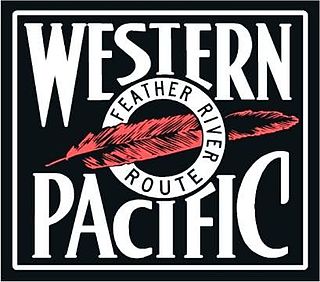
The Western Pacific Railroad was a Class I railroad in the United States. It was formed in 1903 as an attempt to break the near-monopoly the Southern Pacific Railroad had on rail service into northern California. WP's Feather River Route directly competed with SP's portion of the Overland Route for rail traffic between Salt Lake City/Ogden, Utah, and Oakland, California, for nearly 80 years. The Western Pacific was one of the original operators of the California Zephyr passenger line.

The St. Lawrence and Atlantic Railroad, known as St-Laurent et Atlantique Quebec in Canada, is a short-line railway operating between Portland, Maine, on the Atlantic Ocean, and Montreal, Quebec, on the St. Lawrence River. It crosses the Canada–US border at Norton, Vermont, and Stanhope, Quebec, and is owned by short-line operator Genesee & Wyoming.
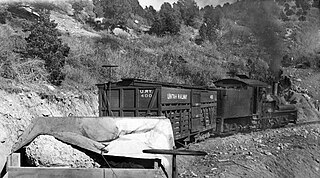
The Uintah Railway was a small 3 ft narrow gauge railroad company in Utah and Colorado in the United States. It was constructed to carry Gilsonite which provided most of its operating revenues; but it operated as a common carrier from 1904 to 1939, also carrying passengers, mail, express, and other cargoes including sheep and wool. When a public library was built in Dragon in 1910, the Uintah Railway agreed to deliver library books free of charge to and from any borrower along its route. Many area ranchers and miners took advantage of the opportunity.

The “Northwestern Pacific Railroad” was a 271 mile mainline railroad from Eureka to ferry connections in Sausalito with a connection to the national railroad system at Schellville. The railroad has gone through a history of different ownership and operators but has maintained a generic name of reference as “The Northwestern Pacific.” Currently, only a 62-mile (100 km) stretch of mainline is operated by Sonoma-Marin Area Rail Transit (SMART), which operates both commuter and freight trains with plans for extension north to Cloverdale, on the “South End.” The “North End,” from Willits to Eureka is currently out of service, but is saved by 2018 legislation to be converted into the Great Redwood Trail.
The Eagle Mountain Railroad (EMRR) was a private railroad in California, owned by the Kaiser Steel Corporation, and is owned today by Kaiser Steel's successor, Kaiser Ventures, Inc. of Ontario, California.

The Santa Fe, Prescott and Phoenix Railway (SFP&P) was a common carrier railroad that later became an operating subsidiary of the Atchison, Topeka and Santa Fe Railway in Arizona. At Ash Fork, Arizona, the SFP&P connected with Santa Fe's operating subsidiary, the Atlantic & Pacific Railroad mainline, that ran from California to Chicago. The SFP&P's 195-mile (314 km) line extended the Santa Fe Railway south into Phoenix. The SFP&P extended another 100 miles (160 km) to the east from Phoenix to Florence and Winkelman via the Phoenix and Eastern Railroad. The SFP&P also served several mines in the Prescott area, including the Derby Mine by way of the Summit (flag) Station at 'Prieta' in the Sierra Prieta range, through its various subsidiary railroads.
The Butte County Railroad was a 31.5-mile (50.7 km) class II railroad that ran from a connection with the Southern Pacific Railroad at Chico, California to the Diamond Match Company lumber mill at Stirling City. The railroad operated from 1903–1915 and then became the Southern Pacific's Stirling City Branch. From 1915 until abandonment in the 1970s the line was operated as the Southern Pacific's Stirling City Branch. The Chico and Northern Railroad was a non-operating subsidiary holding company of the Southern Pacific Railroad that was created to acquire a 32.31 mile line from Chico – Stirling City from the Butte County Railroad. Upon acquiring the line, Chico & Northern immediately leased the line back to the Butte County Railroad. The Chico & Northern was dissolved into Southern Pacific in 1912 and never operated any of the line.

The Cooperstown and Charlotte Valley Railroad Company is a heritage railroad in New York, operated by the Leatherstocking Chapter of the National Railway Historical Society (NRHS) since 1996.
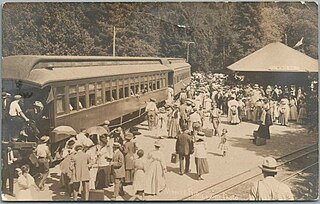
The North Pacific Coast Railroad (NPC) was a common carrier 3 ft (914 mm) narrow-gauge steam railroad begun in 1874 and sold in 1902 to new owners who renamed it the North Shore Railroad (California) (NSR) and which rebuilt the southern section into a standard-gauge electric railway.
The Vaca Valley and Clear Lake Railroad was a standard gauge railroad that operated at Vacaville, California in the late 19th century. The Vaca Valley Railroad was incorporated on April 12, 1869 to run a branch from the mainline of the California Pacific Railroad at Elmira to Rumsey.

The Amador Central Railroad was a standard gauge railroad that operated 11.8 miles (19.0 km) between a connection with the Southern Pacific Company (SP) at Ione and Martell near the town of Jackson, California. The carrier served the Sierra Nevada Foothills gold mining communities and hauled lumber products from the El Dorado National Forest. Amador is the name of the county in which the railroad operated.

The Iowa Northern Railway is a Class III shortline railroad operating in the U.S. state of Iowa.

The Mountain Division is a railroad line that was once owned and operated by the Maine Central Railroad (MEC). It stretches from Portland, Maine on the Atlantic Ocean, through the Western Maine Mountains and White Mountains of New Hampshire, ending at St. Johnsbury, Vermont in the Northeast Kingdom. The line was abandoned in 1983 by MEC's successor, Guilford Transportation Industries (GTI). Guilford retained a stub between Portland and Westbrook. A section in New Hampshire remains in use by heritage railway Conway Scenic Railroad.
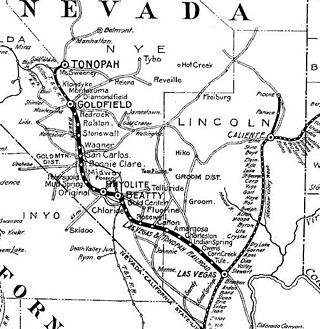
The Las Vegas and Tonopah Railroad was a 197.9-mile (318.5 km) railroad built by William A. Clark that ran northwest from a connection with the mainline of the San Pedro, Los Angeles and Salt Lake Railroad at Las Vegas, Nevada to the gold mines at Goldfield. The SPLA&SL railroad later became part of the Union Pacific Railroad and serves as their mainline between Los Angeles and Salt Lake City.

State Route 427 is a 4.7-mile-long (7.6 km) state highway in the U.S. state of Nevada. It connects the community of Wadsworth in eastern Washoe County to the city of Fernley in western Lyon County. SR 427 comprises the former routing of U.S. Route 40 through the towns it serves. SR 427 also provides an eastern link to Pyramid Lake via a junction with State Route 447 in Wadsworth.

The Overland Route was a train route operated jointly by the Union Pacific Railroad and the Central Pacific Railroad / Southern Pacific Railroad, between Council Bluffs, Iowa / Omaha, Nebraska, and the San Francisco Bay Area, over the grade of the first transcontinental railroad which had been opened on May 10, 1869. Passenger trains that operated over the line included the Overland Flyer, later renamed the Overland Limited, which also included a connection to Chicago. Although these passenger rail trains are no longer in operation, the Overland Route remains a common name for the line from Northern California to Chicago, now owned entirely by the Union Pacific. Although now primarily used for freight, a few portions still provide the route for the California Zephyr passenger train.
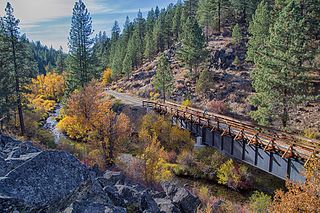
The Fernley & Lassen was a rail line of the Southern Pacific Railroad constructed in 1912–14 between Fernley, Nevada and Westwood, California, near Susanville, a distance of approximately 112 miles (180 km). The railroad was constructed to connect the Red River Lumber Company's facilities in Westwood with the Southern Pacific's main line running through Fernley. After the railroad's construction, it was heavily used by other nearby lumber companies; the Fruit Growers Supply Company maintained the longest-lived railroad connection with the Fernley & Lassen, with an active connection present between 1920–1953. Due to the Great Depression, which significantly lowered freight volume, and the completion of Western Pacific's competing branch to Westwood, however, the Fernley & Lassen's days were numbered. By 1934, passenger traffic service had been discontinued, with local rail freighting following it in 1956. In 1978, the Interstate Commerce Commission approved the Southern Pacific's petition for removal.

Duplainville is a neighborhood located within the city of Pewaukee, Wisconsin. It is around three miles north of Waukesha, and around 15 miles west of Milwaukee. The area is mainly industrial, but is most known among railfans because of the diamond junction between the Canadian Pacific Railway and the Canadian National Railway.
References
- Myrick, David F. (1962). Railroads of Nevada and Eastern California, Volume One - The Northern Roads. Berkeley, California: Howell-North Books. ISBN 0-87417-193-8.
- Robertson, Donald B. (1986). Encyclopedia of Western Railroad History - The Desert States. Caldwell, ID: The Caxton Printers. ISBN 0-87004-305-6.
- Walker, Mike (1997). Steam Powered Video's Comprehensive Railroad Atlas of North America - California and Nevada - Post Merger Ed. Kent, United Kingdom: Steam Powered Publishing. ISBN 1-874745-08-0.